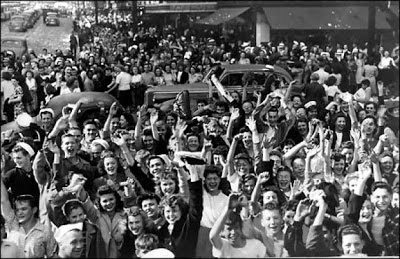In medieval times both men and women wore chemises, but no underpants. By the eighteenth century, women were wearing long pantaloons or drawers, to keep their legs hidden from a stray peep.
By the 20th century, underwear underwent a metamorphosis that caused it to get briefer, synthetic and less constricting. Fashions for underwear, as for other clothing, was linked to social change.
 |
| 1900 (Batterberry) |
 |
| 1910 (Batterberry) |
In Britain in the latter half of the 19th Century, many followers of the Arts and Crafts movement and of the Suffragette movement, shed their corsets and adopted looser, smock type garments as a bid for the freedom and equal rights for women. The corset survived in the milder form of the "girdle", but was certainly not compulsory.
 |
| Look what I found this week! For masochists only. https://www.etsy.com/listing/125794897/white-sequined-corset |
I have a fabulous book called "20th Century Fashion", by John Peacock, which is basically plates of fashion illustrations for every 5 year period from 1900-1989, with descriptions. There are plates for day wear, evening wear, sports wear, couture and accessories for each half of each decade, and I will share a few with you. I hope John Peacock does not mind.
The cotton camisole with separate petticoat were the basic items, along with long drawers, either separate or combined with the cami as camiknickers or combinations. These usually featured an open crotch for practical rather than erotic purposes! An early form of the bra features at the bottom left in a heavily boned corset and "bust supporter".

By 1910, the line of the undergarments is changing in line with the evolution of the outer garments. This underwear features machine made lace. The corset is still in evidence, but it is shrinking.
And just in case you thought all undies were glamorous in the old days, check out these knitted woollies.
(I have the patterns, if you're interested!)

By the twenties, the looser fitting style is more common, although the corset still exists, but once again with a new line. The brassiere has appeared as a separate garment but is a soft, unstructured style. Note the chest flattening corsets. Crepe de chine was a very popular fabric for underwear at this time, taking over from wool.
 |
| Shetland Camibockers - 1928 |

One of my oldest newspaper patterns is from this period. These are "camibockers" knitted in the finest Shetland wool. If you live in a cold climate, you might like to try them.
In the 1930s, the glamorous look of the slinky bias cut dress dress would have made the girdle necessary, at least for evening wear, unless one happened to be waif thin. The bra has become a more structured garment, with boning or underwires. Silk and satin have become the popular fabrics for underwear.
 |
| Onesie |
 |
| Simplicity 2 piece set - late 30s |
But wool is still popular for the winter. Here are some beauties from my favourite Sun-glo book.
I think this model is so beautiful. I often wonder who the models were. Imagine finding your grandmother doing this modelling. Miranda Kerr, eat your heart out.
Coming Soon - Underwear, Part Two.
References:
Batterberry, Michael and Ariane; Fashion - the Mirror of History; 1982; London; Columbus Books
Peacock, John; 20th Century Fashion; 1993; London; Thames and Hudson




